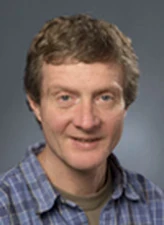Donald Canfield

The 2010 Vladimir Ivanovich Vernadsky Medal is awarded to Donald Canfield for his outstanding contributions to biogeochemistry, encompassing the Earth as a whole in the perspective of the entire expanse of geological time.
Donald Canfield (1958) is one of the world’s most outstanding biogeochemists. His outlook is truly Vernadskian, encompassing the Earth as a whole in the perspective of the entire expanse of geological time. Basically, his method is Huttonian in that he studies Earth dynamics of the present in order to interpret the geological record from the Early Archean to today. His work is exceptionally multidisciplinary, combining microbial ecology, biogeochemistry, geology, palaeontology and related fields. The results of his research are ground-breaking. They greatly deepen our understanding of atmospheric and seawater chemistry and the cycling of bioactive elements through geological history. The “Canfield Ocean”, a sulfidic, partially oxic ocean existing for more than 40% of Earth history, between the Archean and Ediacaran periods, takes its name from his seminal paper (Nature, 1998). This finding has profound implications for biological evolution, and the history of atmospheric oxygen, carbonate sedimentology and climate. For example, Canfield and his co-workers found convincing evidence that a prolonged, stable, oxic environment following the demise of the Canfield Ocean constellation has permitted the emergence of bilateral motile animals some 550 million years ago.
Canfield’s exceptional scientific talents as well as his social intelligence were recognized early on in his career. He was trained by Robert Berner, worked in the stimulating environment of NASA-Ames, USA, and had a permanent position in the prestigious Max Planck Institute for Marine Microbiology in Bremen. In 1996 he was nominated Professor of Ecology at the Institute of Biology in Odense University (Denmark). Soon afterwards he became Co-director of the Danish Center for Earth System Science, and at present he is the Director of the Nordic Center for Earth Evolution. This institution is one of the most important centres of Vernadskyan science, with collaborations all over the world. In 2007 Canfield was elected a member of the National Academy of Sciences in the US. We must be proud that Vernadskyan research of this level of excellence is based within Europe. Canfield has created an inspiring environment where numerous young scientists learn to master the critical discipline of reconstructing Earth history from seemingly insignificant signals in the geological record. This fundamental research has major societal implications: it helps a growing audience to admire the planet that we inhabit and overcome the pernicious fears inspired by global change.
